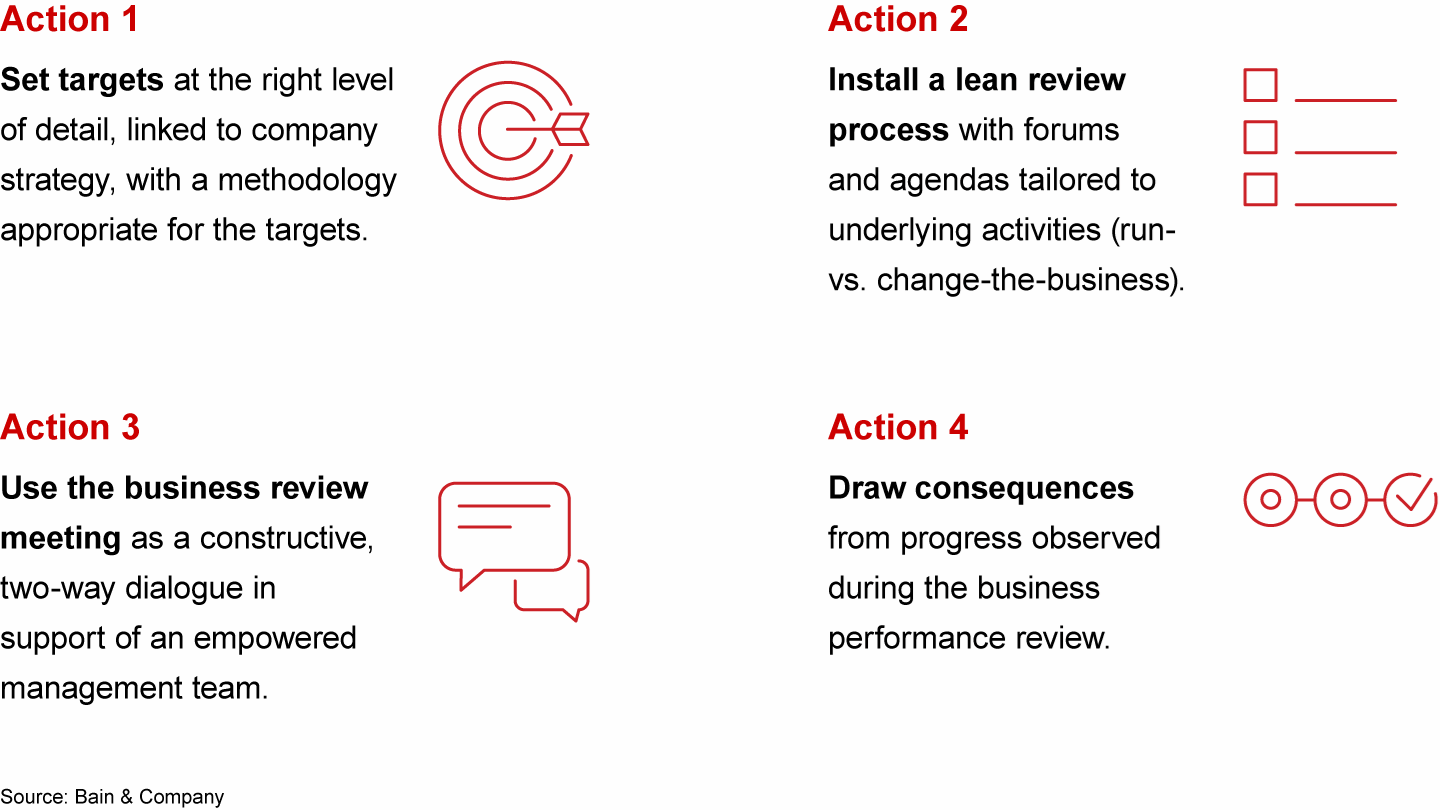Article

Roughly 25% of a CEO’s working time is spent in functional or business unit reviews, according to a Harvard Business Review study by Michael E. Porter and Nitin Nohria. Given what a large slice of leadership time business performance reviews demand, it’s important that they be effective.
Unfortunately, many executives tell us the opposite is true. They find preparations too time-consuming and are not convinced that these reviews consistently meet their primary goal: focusing a business unit, function, or country operation on the right goals and successful execution. These executives dream of an efficient process that is clearly tied to business strategy; that features milestones and targets that can be easily tracked; and that enables discussions in which the questions asked tee up meaningful management engagement instead of backward-looking blame sessions.
Such a well-run business performance review process is powerful. It helps an organization discover what it can do better and focus on pursuing valuable improvements.
Four actions help build more effective business performance reviews (see Figure 1).
Four actions that make business performance reviews more effective


Action 1: Set targets at the right level of detail, linked to company strategy, with a methodology appropriate for the targets.
Designing a business performance review starts with considering the role the organization’s center plays, its relationship to the operating units, and what that implies about the level of target tracking and oversight. A portfolio holding company that isn’t deeply focused on the day-to-day operations of its component businesses, for example, might focus its review on selected financial key performance indicators (KPIs) and meet only once a quarter, leaving detailed operational target setting and evaluation to its business unit executives. By contrast, in companies in which the corporate center executes certain operational activities on behalf of its businesses—for example, in areas like IT, innovation, or sales—the group executives would be likely to conduct more regular business performance reviews that also review operational targets in detail.
Consider the recent experience of a consumer products company. Two business units were combining, so executives took the opportunity to rethink their business performance reviews. They built a new model with refined targets, which were synced to the company’s three- to five-year plan and were better suited to the more empowered geography and brand clusters at the heart of the new operating model. Importantly, as they set new expectations, executives focused on creating meaningful dialogue while avoiding micromanaging those geography and brand clusters.
The target-setting methodology should match the activity involved. Each methodology—KPIs, objectives and key results (OKRs), and simple project milestones, among others—articulates specific things well. For example, the outcomes of “run-the-business” operational activities can be estimated with reasonable accuracy for the next quarter. For these activities, executives can set precise targets with the expectation that the business will achieve those outcomes. For “change-the-business” activities, however, the targets will likely be refined over time. They should be focused on learning and on how those lessons inform whether to continue the initiative as is, accelerate it, or stop altogether. In activities such as the scaling of an insurgent brand, the buildup of a new digital channel, or the implementation of an organizational change project, it might be useful to apply KPIs across both “run” and “change” activities, but OKRs or project milestones are better suited to articulate targets for the “change” activities and could be well employed on top of KPIs.
Action 2: Install a lean review process with forums and agendas tailored to underlying activities (run- vs. change-the-business).
It is common for the number and scope of reviews to proliferate over time, particularly in large organizations. This duplication is made exponentially more time-consuming by generic, lengthy meetings and by the kind of prep packages one telecommunications company referred to as its “115-pagers.”
A well-designed business review thoughtfully addresses the following elements in particular:
- Cadence. Quarterly reviews are typical with lighter, monthly interim check-ins if needed, especially for change-the-business efforts. Proper cadence can be determined by the pace of change in the business and the underlying activities involved in the review.
- Preparation. For quarterly reviews, drop the 115-page pre-read and aim for a good, standard 15-pager. For monthly check-ins, one page is enough. Metrics should ideally be available via regular standardized reporting.
- Agenda. For a run-the-business review, the agenda could include context on KPI development, root causes of any deviations from the plan, and actions to address any issues. More than 70% of the time should be focused on high-value topics or initiatives that are off-track. Covering everything equally is not necessary or efficient. For a change-the-business forum, the agenda could start with a brief progress update, then move on to discuss roadblocks and areas where help is needed, followed by discussion of and agreement on proper focus areas and next steps. This would include the resourcing required and possibly decisions on which projects will move forward and which will stop. An agenda should focus primarily on the areas that are off track or that might be accelerated.
- Duration. Quarterly reviews often take half of a day or a day, with up to one hour required for each business unit or function’s run-the-business meetings and as much as two to three hours for major change-the-business initiatives. The exact timing will vary notably from company to company, however, depending on each company’s size and the number of ongoing initiatives.
- Participants. For quarterly cross-company reviews, the full executive committee usually attends, but monthly check-ins can run with a smaller group of key participants if needed.
- Location. While reviews can be virtual, especially for global companies, many executives find it best to alternate between virtual and on-site meetings. Scheduling reviews adjacent to recurring executive committee meetings can make efficient use of senior team time, but it also risks reduced attention levels given the intense meeting-laden days.
Action 3: Use the business review meeting as a constructive, two-way dialogue in support of an empowered management team.
Effective reviews are not about assigning blame. Their goal is to empower teams and leaders: to set the destination and let teams and leaders chart the path to get there. The role of senior executives is to help clear the way for their success. It’s a balance between control and empowerment that cultivates a two-way dialogue about what can be done better.
This often requires a change in leadership behavior. Rather than being determined by how the CEO or CFO is most comfortable running a meeting, these meetings should be structured to most effectively accomplish their goal. In run-the-business meetings, leaders can focus on understanding the root causes of issues and creating solutions as a team together. In change-the-business meetings, the focus would be on learning and removing roadblocks.
At one personal care company, executives were quite hands-on and highly detail-oriented. As a result, their business performance reviews tended to focus a disproportionate amount of time on why certain things had happened. In an effort to spend less time on the past, more on the future, and empower their teams to take action, they now devote less time to lagging indicators like market share, revenue, and profit, and instead focus on a new set of leading indicators that are consistent across all businesses and countries. Among them: the number of stores in which products are sold, quality of shelf placement, status of innovation, and consumer attitudes.
Action 4: Draw consequences from progress observed during the business performance review.
When it is determined that a unit has fallen short, or that it’s done well, something must change as a result of the review. A leading food company evolved from having rather casual, ever-changing business reviews that were largely focused on explaining what was happening to standardized reviews that made it possible for leaders to compare and apply lessons across different country operations. The new country business reviews led to two important concrete outcomes. First, they ensured clear agreement on the next steps to be taken and on any necessary changes to the resources being given to the country. This process often required follow-up in the form of quick interim check-ins between formal reviews. Second, they generated ideas, lessons, and questions that the central team found worthy of testing in other countries, with the aim of scaling lessons learned as soon as possible. For example, after a new flavor exceeded expectations in France, the company quickly rolled it out to Spain as well.
Some questions worth considering:
- Should we stop a strategic initiative or project, or perhaps even adjust the scope of a line organization?
- Should we adjust the budget or team allocated to a function or initiative?
- Or, more broadly, should we tie progress to the individual compensation of the management team to incentivize the right behavior?
• • •
By following these four actions—setting thoughtful, strategically aligned targets using the right methodology; building a tailored and lean review process; encouraging constructive dialogue with an empowered management team; and then drawing sometimes hard consequences based on progress achieved—companies can create the type of business reviews that not only make the most of executives’ time, but that also make a real difference in company performance.

Creating a Dynamic Management System Built for Speed
In these turbulent times, flexibly prioritizing and allocating resources helps companies make good decisions and focus on what matters most.